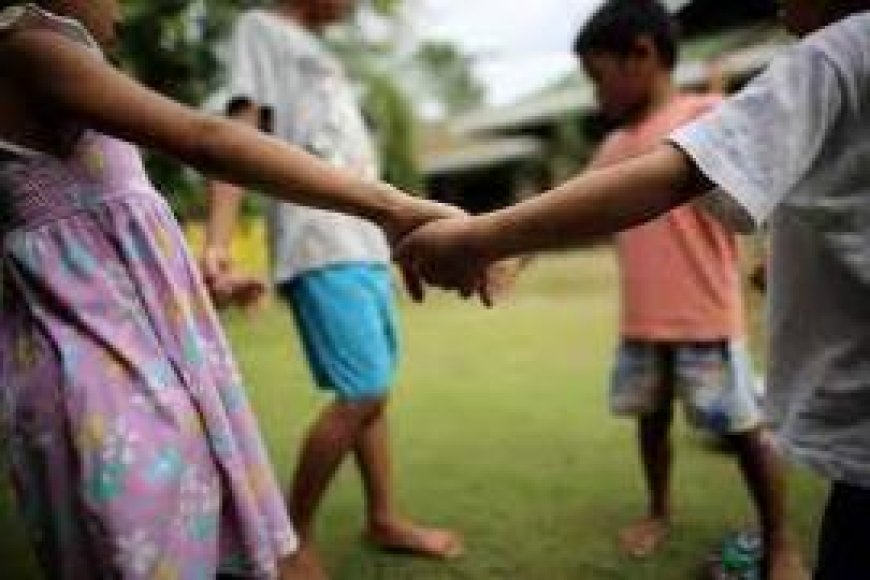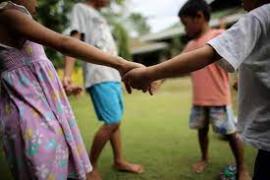Minister Zulu receives review report on child support grant
Minister Zulu receives review report on child support grant South African Government News Agency

The Child Poverty and the Child Support Grant (CSG) Review Report

The Child Poverty and the Child Support Grant (CSG) Review Report not only serves as a barometer, but it is an invitation to found, strengthen and activate multilateral partnerships that will undo child poverty in all communities.
This is according to Social Development Minister Lindiwe Zulu, who received the review report on Friday in Johannesburg, Gauteng.
Partnerships for a Brighter Future
“The Review Report is a challenge to all of us to inspire hope, thereby ensuring a brighter future for all children. To reinforce the CSG’s continued relevance, the department is currently working on a policy through which we will be integrating the receipt of children’s grants with government’s other basic services in the very near future.
“This policy will ensure that these beneficiaries, namely children, will benefit from receiving the diverse bouquet of government’s interventions that will necessarily improve their human development and dignity,” Zulu said.
The Value of the Child Support Grant
In 2021, the Department of Social Development commissioned the Children’s Institute at the University of Cape Town to conduct a comprehensive review of child poverty and the value of the Child Support Grant (CSG).
In its effort to ensure that the right to access social assistance is afforded to all those who are unable to take care of themselves, the South African government has, through the Department of Social Development, rolled out a massive social assistance programme, the most notable being the CSG.
The South African Social Assistance programme stands as a globally recognised model, acknowledged for its strategic role as the nation’s primary poverty alleviation initiative.
Successes of the Child Support Grant
The CSG has been especially successful at reaching large numbers of poor children with relative ease, earning recognition for its pro-poor targeting among existing social grants.
To date, the 13 million children are CSG recipients to the value of R510 a month per child. In the previous financial year (2022/23), the Department of Social Development, through its entity, SASSA, allocated a budget of R77 billion for the payment of this grant.
The CSG remains one of the country’s successful poverty alleviation programmes, which plays a significant role in positive school outcomes, and research has shown that it has ensured that eligible children receiving the CSG remain in school.
Challenges and Recommendations
While it is acknowledged that the CSG has had a significant impact in alleviating poverty, it is provided at a value too small to protect the poorest children from hunger, malnutrition, and stunting, the review noted.
In an effort to augment the current social assistance programme such that it can address the existing gaps, the Department of Social Development said it has, in the past two decades, engaged in policy reforms in the form of scaling up social assistance to cover all the vulnerable groups.
The review assessed the state of child poverty in the country, the impact of the CSG on child poverty, as well as the value of the CSG in the context of child poverty and the cost of raising a child.
The findings of the review are already indicating that poverty rates are higher for women than for men, and higher for children than adults, making it imperative therefore, going forward, to analyse child poverty rates separately, as the extent of child poverty is otherwise obscured by the overall national poverty rates.
The review also found that child poverty in South Africa remains racially and geographically distorted, wherein African children and those living in rural areas in the former homelands, are most likely to be poor.
Child food poverty was also reduced by 20 percentage points from 55% to 33% between 2003 and 2013, as the CSG coverage expanded rapidly with the age threshold being extended from 7 to 18 years.
Several studies demonstrate that the CSG has contributed to improved outcomes for child wellbeing. Furthermore between 2013 and 2019, child poverty rates remained stable and the percentage of children below the upper bound poverty line started to show improvement in 2017.
The review also records that the introduction of the COVID-19 Social Relief of Distress, the caregiver allowance and top-ups to the permanent grants helped to offset increases in child poverty for a few months in 2020. It has been found that these temporary measures to boost grant income “saved” an estimated 1.2 million children from food poverty for a few months.
The review also notes that child poverty and hunger rates increased after the caregiver allowance and top-ups ended in October 2020.
It further reveals that in 2021, child poverty had risen significantly, with 37% of children (over 7 million) living in food poverty and 62% below the upper bound poverty line.
It has also been found that delays in birth registration and CSG applications during lockdown resulted in the number of babies receiving the CSG falling by about 100 000 in 2021 with no recovery to 2019 levels by March 2022.
As a result of many years of annual CSG increases below food inflation, the purchasing power of the CSG has been eroded and it no longer covers the cost of food and clothing for a child as originally intended.
The review further highlights that should the status quo continue, the gap between the value of the CSG and the food poverty line will widen further every year, with the rate and number of children living in food poverty continuing to rise.
The study, inter alia, recommends that the food poverty line – at R663/child/month – should be regarded as the absolute minimum, while the upper bound poverty line – at R1 417/child/month – should not be seen as generous. – SAnews.gov.za
SDGs, Targets, and Indicators Analysis
1. Which SDGs are addressed or connected to the issues highlighted in the article?
- SDG 1: No Poverty
- SDG 2: Zero Hunger
- SDG 4: Quality Education
- SDG 5: Gender Equality
- SDG 10: Reduced Inequalities
The article addresses issues related to child poverty, child support grants, and their impact on various aspects of children’s lives. These issues are connected to the Sustainable Development Goals mentioned above.
2. What specific targets under those SDGs can be identified based on the article’s content?
- Target 1.2: By 2030, reduce at least by half the proportion of men, women, and children of all ages living in poverty in all its dimensions according to national definitions.
- Target 2.1: By 2030, end hunger and ensure access by all people, in particular the poor and people in vulnerable situations, including infants, to safe, nutritious, and sufficient food all year round.
- Target 4.1: By 2030, ensure that all girls and boys complete free, equitable, and quality primary and secondary education leading to relevant and effective learning outcomes.
- Target 5.2: Eliminate all forms of violence against all women and girls in the public and private spheres, including trafficking and sexual and other types of exploitation.
- Target 10.2: By 2030, empower and promote the social, economic, and political inclusion of all, irrespective of age, sex, disability, race, ethnicity, origin, religion, or economic or other status.
The article discusses the impact of child poverty and the Child Support Grant (CSG) on poverty reduction, hunger, education, gender equality, and reducing inequalities. These targets are relevant to the issues highlighted in the article.
3. Are there any indicators mentioned or implied in the article that can be used to measure progress towards the identified targets?
- Indicator 1.2.1: Proportion of population living below the national poverty line, by sex and age.
- Indicator 2.1.2: Prevalence of moderate or severe food insecurity in the population, based on the Food Insecurity Experience Scale (FIES).
- Indicator 4.1.1: Proportion of children and young people (a) in grades 2/3; (b) at the end of primary; and (c) at the end of lower secondary achieving at least a minimum proficiency level in (i) reading and (ii) mathematics, by sex.
- Indicator 5.2.1: Proportion of ever-partnered women and girls aged 15 years and older subjected to physical, sexual, or psychological violence by a current or former intimate partner in the previous 12 months, by form of violence and by age group.
- Indicator 10.2.1: Proportion of people living below 50 percent of median income, by age, sex, and persons with disabilities.
The article provides information that can be used to measure progress towards the identified targets. It mentions child poverty rates, food poverty rates, the impact of the CSG on education outcomes, and the prevalence of violence against women and girls. These indicators can be used to track progress in achieving the targets.
4. Table: SDGs, Targets, and Indicators
| SDGs | Targets | Indicators |
|---|---|---|
| SDG 1: No Poverty | Target 1.2: By 2030, reduce at least by half the proportion of men, women, and children of all ages living in poverty in all its dimensions according to national definitions. | Indicator 1.2.1: Proportion of population living below the national poverty line, by sex and age. |
| SDG 2: Zero Hunger | Target 2.1: By 2030, end hunger and ensure access by all people, in particular the poor and people in vulnerable situations, including infants, to safe, nutritious, and sufficient food all year round. | Indicator 2.1.2: Prevalence of moderate or severe food insecurity in the population, based on the Food Insecurity Experience Scale (FIES). |
| SDG 4: Quality Education | Target 4.1: By 2030, ensure that all girls and boys complete free, equitable, and quality primary and secondary education leading to relevant and effective learning outcomes. | Indicator 4.1.1: Proportion of children and young people (a) in grades 2/3; (b) at the end of primary; and (c) at the end of lower secondary achieving at least a minimum proficiency level in (i) reading and (ii) mathematics, by sex. |
| SDG 5: Gender Equality | Target 5.2: Eliminate all forms of violence against all women and girls in the public and private spheres, including trafficking and sexual and other types of exploitation. | Indicator 5.2.1: Proportion of ever-partnered women and girls aged 15 years and older subjected to physical, sexual, or psychological violence by a current or former intimate partner in the previous 12 months, by form of violence and by age group. |
| SDG 10: Reduced Inequalities | Target 10.2: By 2030, empower and promote the social, economic, and political inclusion of all, irrespective of age, sex, disability, race, ethnicity, origin, religion, or economic or other status. | Indicator 10.2.1: Proportion of people living below 50 percent of median income, by age, sex, and persons with disabilities. |
The table summarizes the relevant SDGs, targets, and indicators identified in the article. These goals, targets, and indicators are connected to the issues discussed in the article and can be used to measure progress towards addressing child poverty and the impact of the Child Support Grant.
Behold! This splendid article springs forth from the wellspring of knowledge, shaped by a wondrous proprietary AI technology that delved into a vast ocean of data, illuminating the path towards the Sustainable Development Goals. Remember that all rights are reserved by SDG Investors LLC, empowering us to champion progress together.
Source: sanews.gov.za

Join us, as fellow seekers of change, on a transformative journey at https://sdgtalks.ai/welcome, where you can become a member and actively contribute to shaping a brighter future.







